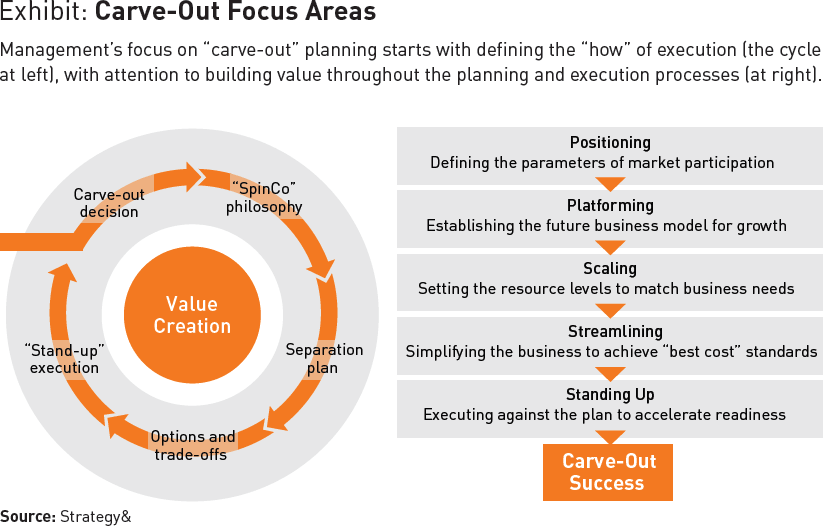How to Avoid “Carve-Out” Surprises
Careful planning for an independent future can maximize value when companies liberate assets.
Companies have traditionally sought to create shareholder value through the process of addition. They build broad-based business portfolios via growth strategies or product innovation, and bulk up through mergers and acquisitions. In this market cycle, however, investors seem to prefer simpler and clearer business models to complicated stories. As a result, there is rising pressure — and increasing opportunity — to add value through subtraction. In an effort to provide more compelling value propositions, many companies have pursued a broader and less traditional range of structural options that simplify matters and clarify business priorities: divestments, and the spin-outs of business units or assets into real estate investment trusts, master limited partnerships, or yield companies (“yieldcos”), which provide stable and more predictable cash flows.
Each of these “carve-out” mechanisms has a place in the portfolio of strategic reconstruction, depending on its applicability to the asset base or business. In recent years we have seen their adoption in transactions such as Duke Energy’s spin-out of Spectra Energy, CenterPoint Energy’s and OGE Energy’s IPO of Enable Midstream Partners, and NextEra Energy’s formation of its yieldco, NextEra Energy Partners. The positive market reception to these carve-outs when they occurred highlights how nontraditional restructurings can unlock value in unique ways.
But restructuring or separating business units to match investor sentiment is often neither simple nor certain. Smart companies are finding that the early recognition and consideration of the challenges that accompany a carve-out can avoid unwelcome surprises later.
The First Order of Business
Management decisions to carve-out a business often generate a great deal of excitement about what the future will look like for both the soon-to-be separated company and the original enterprise. Management team members and employees intuitively feel that the carve-out will cure whatever market misperceptions have contributed to the company’s past undervaluation, while those who will run the soon-to-be-free entity look forward to greater independence. As a result, management can focus too much on executing the separation quickly and defining the company’s future beyond the carve-out. In doing so, they often overlook important elements that increase the risks of successful execution and value realization for the new entity, and can also create unwelcome and untimely distractions for management of both the parent company and carve-out after separation.
Many of these problems are avoidable. Four specific challenges that have arisen in several recent carve-outs provide lessons that can help management side-step adverse separation outcomes. These are particularly on point for structural carve-outs — i.e., divestments and spin-offs, in which standing up a successful new company is a significant obstacle.
• Underestimating carve-out requirements. Management teams often fail to recognize the complexity and execution demands a carve-out creates. In many cases, the business may be relatively small compared to the overall enterprise, and management assumes that the separation is simple and has minimal overall impact. In other cases, management assumes that the separation requirements are straightforward and leave little room for judgement. Generally, neither is true, and these perceptions tend to lull management into a false sense of security.
The manifold requirements of a carve-out include financial structuring, business valuation, operating model design, organization stand-up, infrastructure separation, staffing alignment, cost distribution, market readiness, and a variety of additional areas of consideration and preparation.
Underestimating carve-out separation planning and execution requirements frequently leads to timeline progression and readiness problems. To avoid them, management needs to treat any proposed carve-out as a priority and not just another project. Formal leadership, enterprise mobilization, and detailed action planning should be cornerstones of carve-out planning and execution.
• Conservatism in go-to-market strategy. Although the focus of the carve-out is to get into the market as quickly as possible, investors are also interested in how the new entity will compete and create value. Management often emphasizes the stand-up of the new entity rather than its post-separation competitiveness, partly because responsibility for post-separation strategy development and market performance will fall to the carve-out’s management. But when a company loses market momentum after separation due to an underdeveloped or oversimplified first-year strategy, it can undercut the original rationale for the separation.
In formulating the carve-out strategy, management needs to consider where in the market the new entity will choose to play, how the new entity will compete, and how the separated company will win in the market. A robust and complete go-to-market strategy thus needs to be designed for the competitive future of the separated company rather than for the competitive position that existed when it was part of a larger enterprise. Strategy needs to be developed well before the separation — not left to new management.
Strategy needs to be developed well before the separation — not left to new management.
• Maintaining unnecessary business complexity. In the rush to get to Day One of the separation, management often considers only the requirements to separate and operate the carve-out business, rather than the need to also improve it to operate effectively. Management frequently takes the approach that what exists today is the same as what needs to exist tomorrow. And so they transfer the existing infrastructure and platforms rather than redesign, adapt, or replace them.
Management can select from several approaches to standing-up the new business — clone and go, fit-for-purpose, or build to suit. Any of the approaches can work. But each bears trade-offs in both cost and effectiveness related to the ongoing needs of a smaller and simpler business. Each approach also has strengths and weaknesses regarding the ability to satisfy the core needs of the separated business without saddling it with unnecessary infrastructure, processes, and complexity.
To avoid leaving the carve-out in an uneconomic or uncompetitive position post-close, management needs to focus on simplicity. The newly separated business needs to be self-sufficient shortly after stand-up occurs. But it also needs to be as lean as possible so that it can optimize margins and solidify market performance. This simplification is best accomplished by empowering the new management team to define the minimum level of requirements that will position the business to grow and deliver in the first year, and by dropping infrastructure platforms that do not support these objectives.
• Underperforming market expectations. Carve-outs commonly fail to deliver on first-year commitments. Although the investment community can be forgiving in that time frame, competitors may seize the moment to make an offer to the new entity’s shareholders, claiming they can manage the business better than the current management team. As a smaller entity outside the former parent company’s umbrella, the carve-out will now be subject to the vagaries of the market’s impatience for results.
Strategic decisions prior to the separation, planning inadequacies in the run-up to separation, or simple execution failures after the carve-out can lead to disappointing performance. Management often doesn’t realize the value of detailed planning for the separation or the need for precision in executing against that plan. Once again, the emphasis on simply getting to Day One can mask future difficulties.
The best way to avoid post-close underperformance is to define and understand the risks in achieving expected outcomes, and to recognize the potential need for mitigation within separation planning. These mechanisms help anticipate negative outcomes and define actions that can be undertaken early in the planning process to identify and nullify threats.
Planning for the Unexpected
Markets notice when carve-out preparation and follow-through have not been executed well. To avoid the types of performance challenges that often occur in carve-outs, management teams need to engage in a careful balancing act. They must consider what adverse carve-out events could happen (pre- and post-separation) and what actions they can take to ensure that planned outcomes are fully realized, rather than unnecessarily foregone.

A variety of elements go into structuring and implementing a successful carve-out process (see exhibit). The first step is to define the philosophy that will drive the desired outcomes from the separation, e.g., market positioning to unlock value. A detailed and comprehensive plan to shape the spun-off company — i.e., “SpinCo” — according to this philosophy provides the road map for execution and defines the internal strategic and operating platform to build upon. Next, management tests the plan against alternative approaches and outcomes to evaluate unexpected impacts and sharpen the activities to be carried out. Finally, execution must be carefully managed to recognize the complexity of the separation and either scale or streamline the resources necessary to support the carve-out. Throughout the planning and execution process, management must also focus on how it can build value through effective scaling and streamlining of the newly independent entities.
Carve-out of assets or a business can be a valuable lever when smartly used by management to unlock unrecognized value. Bringing informed foresight to the carve-out planning process is a fundamental ingredient to ensure that asset or business subtraction actually leads to the addition of incremental value.





